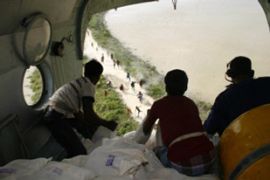No sign of relief in S Asia floods
The worst floods in living memory could trigger an outbreak of disease.

Every year, monsoon rains leave a trail of destruction across South Asia, but much of the economy of the largely agricultural region depends on the downpours.
However, in the past two weeks, some of the worst floods in living memory have affected at least 25 million people in the region, 10 million of them made homeless or left stranded.
Crops have been destroyed as rivers burst their banks.
Much of eastern India and two-thirds of Bangladesh’s 64 districts are inundated.
Indian government figures cited by the United Nations Children’s Fund (Unicef), say that more than 1,100 people have died in this year’s monsoon, not including all the latest casualties.
Desperate conditions
Health workers who are already struggling to cope with large numbers of fever and dysentery cases fear that, as people return to rebuild their homes, stagnant water and mud will provide a breeding ground for mosquitoes.
| “Relief efforts from the government is not in tune with the reality on the ground”
Dr Unnikrishnan PV, ActionAid |
Federal ministers are to visit Assam on Tuesday, to examine the situation after complaints that local officials have moved too slowly to assess the damage and appeal for relief.
Sanjiv Nath, a teacher, said: “While we never expect a perfect government, the chief minister should have at least taken the trouble to visit the flood-affected areas.”
Dr Unnikrishnan PV, an emergencies expert at ActionAid, a relief organisation, told Al-Jazeera that the Indian government must do more to assist those affected.
In Bihar state, four air force helicopters have dropped food, medicines and clothing to some of the 10 million affected in the state, where floods have worsened.
Ramesh Kumar Das, a defence ministry spokesman in Kolkata, said: “Each pilot is carrying out 12 sorties a day and they have reported huge devastation in central and north Bihar.”
Siraj Ahmed, a villager, telling local television reporters in Bihar, said: “I have been dividing one small piece of bread among four of my children, and I have been starving and somehow surviving.”
In neighbouring Orissa and Uttar Pradesh, 39 people have died since Saturday.
Bangladesh worsening
In Bangladesh, 120 people are now confirmed dead, with 39 more drowning or dying from snakebites, a senior official at the government’s flood monitoring agency said.
 |
|
A Bangladeshi child carries a plate |
At least 37 others are missing.
Up to 20 million people in more than 40 of the country’s 64 districts have been affected, while up to 300,000 had moved into relief camps or were living on raised roads and river embankments.
Half of Bangladesh’s capital, Dhaka, is under water, forcing many to take shelter with relatives and friends.
Meanwhile, shortages of food, safe drinking water and medicines have triggered outbreaks of diarrhoea, dysentery and other waterborne diseases in the shelters.
Weather officials had said that the floods were receding in the north, but the situation could worsen in central districts and in Dhaka.
The country’s army-backed government has promised an all-out effort to save flood victims but relief efforts were inadequate, officials have said.
Political parties have refused to participate in the relief effort, demanding that the government ends a ban on their activity.
In Nepal, a UN body has said that weeks of rains have triggered floods and landslides, killing 84 people.